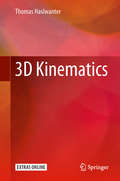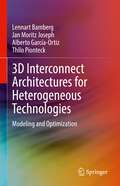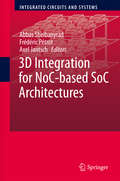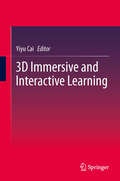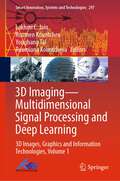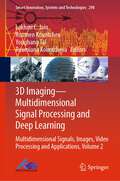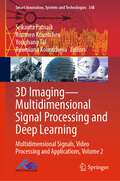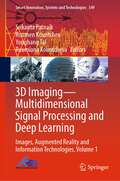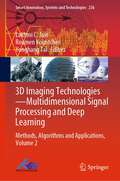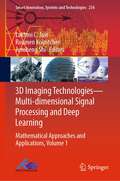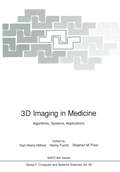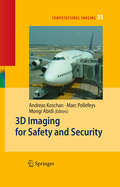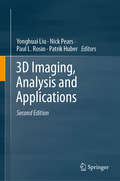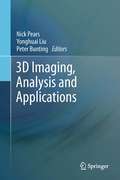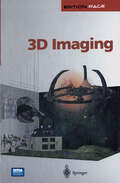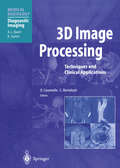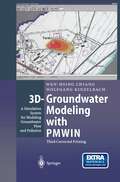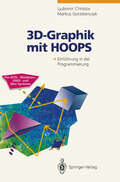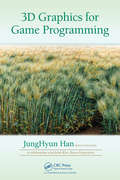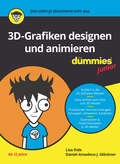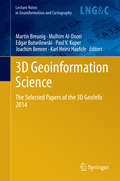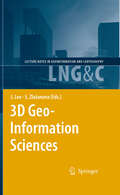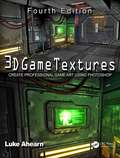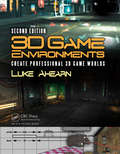- Table View
- List View
3D Kinematics
by Thomas HaslwanterThis book presents an introduction to the analysis of general movements in 3D space, especially for movements of the human body. It is based on the lecture notes of a class on 3D Kinematics, which the author has been holding in the Master Degree Program of his home institution, the University of Applied Sciences Upper Austria. The lecture introduces the mathematics underlying the measurement and analysis of 3D movements. The target audience primarily comprises research experts in the field, but the book may also be beneficial for graduate students alike.
3D Interconnect Architectures for Heterogeneous Technologies: Modeling and Optimization
by Lennart Bamberg Jan Moritz Joseph Alberto García-Ortiz Thilo PionteckThis book describes the first comprehensive approach to the optimization of interconnect architectures in 3D systems on chips (SoCs), specially addressing the challenges and opportunities arising from heterogeneous integration. Readers learn about the physical implications of using heterogeneous 3D technologies for SoC integration, while also learning to maximize the 3D-technology gains, through a physical-effect-aware architecture design. The book provides a deep theoretical background covering all abstraction-levels needed to research and architect tomorrow’s 3D-integrated circuits, an extensive set of optimization methods (for power, performance, area, and yield), as well as an open-source optimization and simulation framework for fast exploration of novel designs.
3D Integration for NoC-based SoC Architectures (Integrated Circuits and Systems)
by Abbas Sheibanyrad Frédéric Pétrot Axel JantschThis book presents the research challenges that are due to the introduction of the 3rd dimension in chips for researchers and covers the whole architectural design approach for 3D-SoCs. Nowadays the 3D-Integration technologies, 3D-Design techniques, and 3D-Architectures are emerging as interesting, truly hot, broad topics. The present book gathers the recent advances in the whole domain by renowned experts in the field to build a comprehensive and consistent book around the hot topics of three-dimensional architectures and micro-architectures. This book includes contributions from high level international teams working in this field.
3D Immersive and Interactive Learning
by Yiyu Cai3D technology is not new; research on 3D started back in early 1960s. But unlike in previous times, 3D technology has now rapidly entered our daily life from cinema to office to home. Using 3D for education is a new yet challenging task. This book will present several innovative efforts using 3D for immersive and interactive learning covering a wide spectrum of education including gifted program, normal (technical) stream, and special needs education. The book will also share experience on curriculum-based 3D learning in classroom setting and co-curriculum-based 3D student research projects. The book is organized as follows. Chapter 1 introduces the fundamentals of 3D educational technology and their applications in immersive and interactive learning. Chapter 2 discusses the use of virtual reality in teaching and learning of Molecular Biology. Chapter 3 presents the daVinci Lab @ River Valley High School. Chapter 4 describes the 3D education development process. Chapter 5 studies the adaption 3D system for learning gains in lower secondary normal (technical) stream. Chapter 6 investigates the effects of virtual reality technology on spatial visualization skills. Chapter 7 showcases a sabbatical program for students to use 3D for Science, Technology, Engineering and Mathematics (STEM) learning. Chapter 8 shares the use of 3D virtual pink dolphin to assist special education. The foreword of this book is written by Dr Cheah Horn Mun, Director, Education Technology Division, Ministry of Education, Singapore.
3D Imaging—Multidimensional Signal Processing and Deep Learning: 3D Images, Graphics and Information Technologies, Volume 1 (Smart Innovation, Systems and Technologies #297)
by Lakhmi C. Jain Roumen Kountchev Yonghang Tai Roumiana KountchevaThis book gathers selected papers presented at the conference “Advances in 3D Image and Graphics Representation, Analysis, Computing and Information Technology,” one of the first initiatives devoted to the problems of 3D imaging in all contemporary scientific and application areas. The two volumes of the book cover wide area of the aspects of the contemporary multidimensional imaging and outline the related future trends from data acquisition to real-world applications based on new techniques and theoretical approaches. This volume contains papers devoted to the theoretical representation and analysis of the 3D images. The related topics included are 3D image transformation, 3D tensor image representation, 3D content generation technologies, 3D graphic information processing, VR content generation technologies, multi-dimensional image processing, dynamic and auxiliary 3D displays, VR/AR/MR device, VR camera technologies, 3D imaging technologies and applications, 3D computer vision, 3D video communications, 3D medical images processing and analysis, 3D remote sensing images and systems, deep learning for image restoration and recognition, neural networks for MD image processing, etc.
3D Imaging—Multidimensional Signal Processing and Deep Learning: Multidimensional Signals, Images, Video Processing and Applications, Volume 2 (Smart Innovation, Systems and Technologies #298)
by Lakhmi C. Jain Roumen Kountchev Yonghang Tai Roumiana KountchevaThis book gathers selected papers presented at the conference “Advances in 3D Image and Graphics Representation, Analysis, Computing and Information Technology,” one of the first initiatives devoted to the problems of 3D imaging in all contemporary scientific and application areas. The two volumes of the book cover wide area of the aspects of the contemporary multidimensional imaging and outline the related future trends from data acquisition to real-world applications based on new techniques and theoretical approaches. This volume contains papers aimed at the multidimensional systems and signal processing, deep learning, mathematical approaches and the related applications. The related topics are multidimensional multi-component image processing; multidimensional image representation and super-resolution; compression of multidimensional spatio-temporal images; multidimensional image transmission systems; multidimensional signal processing; prediction and filtering of multidimensional process; intelligent multi-spectral and hyper-spectral image processing, intelligent multi-view image processing, 3D deep learning, 3D GIS and graphic database; data-based MD image retrieval and knowledge data mining; watermarking, hiding and encryption of MD images; intelligent visualization of MD images; forensic analysis systems for M3D graphics algorithm; 3D VR (Virtual Reality)/AR (Augmented Reality); applications of multidimensional signal processing; applications of multidimensional systems; multidimensional filters and filter-banks.
3D Imaging—Multidimensional Signal Processing and Deep Learning: Multidimensional Signals, Video Processing and Applications, Volume 2 (Smart Innovation, Systems and Technologies #348)
by Srikanta Patnaik Roumen Kountchev Yonghang Tai Roumiana KountchevaThis book presents high-quality research in the field of 3D imaging technology. The fourth edition of International Conference on 3D Imaging Technology (3DDIT-MSP&DL) continues the good traditions already established by the first three editions of the conference to provide a wide scientific forum for researchers, academia and practitioners to exchange newest ideas and recent achievements in all aspects of image processing and analysis, together with their contemporary applications. The conference proceedings are published in 2 volumes. The main topics of the papers comprise famous trends as: 3D image representation, 3D image technology, 3D images and graphics, and computing and 3D information technology. In these proceedings, special attention is paid at the 3D tensor image representation, the 3D content generation technologies, big data analysis, and also deep learning, artificial intelligence, the 3D image analysis and video understanding, the 3D virtual and augmented reality, and many related areas. The first volume contains papers in 3D image processing, transforms and technologies. The second volume is about computing and information technologies, computer images and graphics and related applications. The two volumes of the book cover a wide area of the aspects of the contemporary multidimensional imaging and the related future trends from data acquisition to real-world applications based on various techniques and theoretical approaches.
3D Imaging—Multidimensional Signal Processing and Deep Learning: Images, Augmented Reality and Information Technologies, Volume 1 (Smart Innovation, Systems and Technologies #349)
by Srikanta Patnaik Roumen Kountchev Yonghang Tai Roumiana KountchevaThis book presents high-quality research in the field of 3D imaging technology. The fourth edition of International Conference on 3D Imaging Technology (3DDIT-MSP&DL) continues the good traditions already established by the first three editions of the conference to provide a wide scientific forum for researchers, academia, and practitioners to exchange newest ideas and recent achievements in all aspects of image processing and analysis, together with their contemporary applications. The conference proceedings are published in two volumes. The main topics of the papers comprise famous trends as: 3D image representation, 3D image technology, 3D images and graphics, and computing and 3D information technology. In these proceedings, special attention is paid at the 3D tensor image representation, the 3D content generation technologies, big data analysis, and also deep learning, artificial intelligence, the 3D image analysis and video understanding, the 3D virtual and augmented reality, and many related areas. The first volume contains papers in 3D image processing, transforms, and technologies. The second volume is about computing and information technologies, computer images and graphics and related applications. The two volumes of the book cover a wide area of the aspects of the contemporary multidimensional imaging and the related future trends from data acquisition to real-world applications based on various techniques and theoretical approaches.
3D Imaging Technologies—Multidimensional Signal Processing and Deep Learning: Methods, Algorithms and Applications, Volume 2 (Smart Innovation, Systems and Technologies #236)
by Lakhmi C. Jain Roumen Kountchev Yonghang TaiThis book presents high-quality research in the field of 3D imaging technology. The second edition of International Conference on 3D Imaging Technology (3DDIT-MSP&DL) continues the good traditions already established by the first 3DIT conference (IC3DIT2019) to provide a wide scientific forum for researchers, academia and practitioners to exchange newest ideas and recent achievements in all aspects of image processing and analysis, together with their contemporary applications. The conference proceedings are published in 2 volumes. The main topics of the papers comprise famous trends as: 3D image representation, 3D image technology, 3D images and graphics, and computing and 3D information technology. In these proceedings, special attention is paid at the 3D tensor image representation, the 3D content generation technologies, big data analysis, and also deep learning, artificial intelligence, the 3D image analysis and video understanding, the 3D virtual and augmented reality, and many related areas. The first volume contains papers in 3D image processing, transforms and technologies. The second volume is about computing and information technologies, computer images and graphics and related applications. The two volumes of the book cover a wide area of the aspects of the contemporary multidimensional imaging and the related future trends from data acquisition to real-world applications based on various techniques and theoretical approaches.
3D Imaging Technologies—Multi-dimensional Signal Processing and Deep Learning: Mathematical Approaches and Applications, Volume 1 (Smart Innovation, Systems and Technologies #234)
by Lakhmi C. Jain Roumen Kountchev Junsheng ShiThis book presents high-quality research in the field of 3D imaging technology. The second edition of International Conference on 3D Imaging Technology (3DDIT-MSP&DL) continues the good traditions already established by the first 3DIT conference (IC3DIT2019) to provide a wide scientific forum for researchers, academia and practitioners to exchange newest ideas and recent achievements in all aspects of image processing and analysis, together with their contemporary applications. The conference proceedings are published in 2 volumes. The main topics of the papers comprise famous trends as: 3D image representation, 3D image technology, 3D images and graphics, and computing and 3D information technology. In these proceedings, special attention is paid at the 3D tensor image representation, the 3D content generation technologies, big data analysis, and also deep learning, artificial intelligence, the 3D image analysis and video understanding, the 3D virtual and augmented reality, and many related areas. The first volume contains papers in 3D image processing, transforms and technologies. The second volume is about computing and information technologies, computer images and graphics and related applications. The two volumes of the book cover a wide area of the aspects of the contemporary multidimensional imaging and the related future trends from data acquisition to real-world applications based on various techniques and theoretical approaches.
3D Imaging in Medicine: Algorithms, Systems, Applications (NATO ASI Subseries F: #60)
by Karl H. Höhne Henry Fuchs Stephen M. PizerThe visualization of human anatomy for diagnostic, therapeutic, and educational pur poses has long been a challenge for scientists and artists. In vivo medical imaging could not be introduced until the discovery of X-rays by Wilhelm Conrad ROntgen in 1895. With the early medical imaging techniques which are still in use today, the three-dimensional reality of the human body can only be visualized in two-dimensional projections or cross-sections. Recently, biomedical engineering and computer science have begun to offer the potential of producing natural three-dimensional views of the human anatomy of living subjects. For a broad application of such technology, many scientific and engineering problems still have to be solved. In order to stimulate progress, the NATO Advanced Research Workshop in Travemiinde, West Germany, from June 25 to 29 was organized. It brought together approximately 50 experts in 3D-medical imaging from allover the world. Among the list of topics image acquisition was addressed first, since its quality decisively influences the quality of the 3D-images. For 3D-image generation - in distinction to 2D imaging - a decision has to be made as to which objects contained in the data set are to be visualized. Therefore special emphasis was laid on methods of object definition. For the final visualization of the segmented objects a large variety of visualization algorithms have been proposed in the past. The meeting assessed these techniques.
3D Imaging for Safety and Security (Computational Imaging and Vision #35)
by Andreas Koschan Marc Pollefeys Mongi AbidiThis book presents the thoroughly revised versions of lectures given by leading researchers during the Workshop on Advanced 3D Imaging for Safety and Security in conjunction with the International Conference on Computer Vision and Pattern Recognition CVPR 2005, held in San Diego, CA, USA in June 2005. It covers the current state of the art in 3D imaging for safety and security.
3D Imaging, Analysis and Applications
by Yonghuai Liu Nick Pears Paul L. Rosin Patrik HuberThis textbook is designed for postgraduate studies in the field of 3D Computer Vision. It also provides a useful reference for industrial practitioners; for example, in the areas of 3D data capture, computer-aided geometric modelling and industrial quality assurance. This second edition is a significant upgrade of existing topics with novel findings. Additionally, it has new material covering consumer-grade RGB-D cameras, 3D morphable models, deep learning on 3D datasets, as well as new applications in the 3D digitization of cultural heritage and the 3D phenotyping of crops. Overall, the book covers three main areas: ● 3D imaging, including passive 3D imaging, active triangulation 3D imaging, active time-of-flight 3D imaging, consumer RGB-D cameras, and 3D data representation and visualisation; ● 3D shape analysis, including local descriptors, registration, matching, 3D morphable models, and deep learning on 3D datasets; and ● 3D applications, including 3D face recognition, cultural heritage and 3D phenotyping of plants. 3D computer vision is a rapidly advancing area in computer science. There are many real-world applications that demand high-performance 3D imaging and analysis and, as a result, many new techniques and commercial products have been developed. However, many challenges remain on how to analyse the captured data in a way that is sufficiently fast, robust and accurate for the application. Such challenges include metrology, semantic segmentation, classification and recognition. Thus, 3D imaging, analysis and their applications remain a highly-active research field that will continue to attract intensive attention from the research community with the ultimate goal of fully automating the 3D data capture, analysis and inference pipeline.
3D Imaging, Analysis and Applications
by Nick Pears, Yonghuai Liu and Peter Bunting3D Imaging, Analysis and Applications brings together core topics, both in terms of well-established fundamental techniques and the most promising recent techniques in the exciting field of 3D imaging and analysis. Many similar techniques are being used in a variety of subject areas and applications and the authors attempt to unify a range of related ideas. With contributions from high profile researchers and practitioners, the material presented is informative and authoritative and represents mainstream work and opinions within the community.Composed of three sections, the first examines 3D imaging and shape representation, the second, 3D shape analysis and processing, and the last section covers 3D imaging applications. Although 3D Imaging, Analysis and Applications is primarily a graduate text, aimed at masters-level and doctoral-level research students, much material is accessible to final-year undergraduate students. It will also serve as a reference text for professional academics, people working in commercial research and development labs and industrial practitioners.
3D Image Processing: Techniques and Clinical Applications (Medical Radiology)
by A. L. Baert D. Caramella C. BartolozziFew fields have witnessed such impressive advances as the application of computer technology to radiology. The progress achieved has revolutionized diagnosis and greatly facilitated treatment selection and accurate planning of procedures. This book, written by leading experts from many different countries, provides a comprehensive and up-to-date overview of the role of 3D image processing. The first section covers a wide range of technical aspects in an informative way. This is followed by the main section, in which the principal clinical applications are described and discussed in depth. To complete the picture, the final section focuses on recent developments in functional imaging and computer-aided surgery. This book will prove invaluable to all who have an interest in this complex but vitally important field.
3D-Groundwater Modeling with PMWIN: A Simulation System for Modeling Groundwater Flow and Pollution
by Wen-Hsing Chiang Wolfgang KinzelbachThis book and CD-ROM offer a complete simulation system for modeling groundwater flow and transport processes. The companion full-version software (PMWIN) comes with a professional graphical user-interface, supported models and programs and several other useful modeling tools. Tools include a Presentation Tool, a Result Extractor, a Field Interpolator, a Field Generator, a Water Budget Calculator and a Graphic Viewer. Book and CD-ROM are targeted at novice and experienced groundwater modelers.
3D-Graphik mit HOOPS: Einführung in die Programmierung
by Ljubomir Christov Markus GorzelanczykDieses Buch ist sowohl eine systematische Einführung in das 3D-Grafiksystem HOOPS (Hierarchical Object-Oriented Picture System) als auch ein ausführliches Handbuch für dessen Programmierung. Es wird vorausgesetzt, daß der Benutzer die Grundbegriffe der Computergrafik beherrscht. Der Neuling, der Hoops kennen- und nutzen lernen möchte, kann das Buch als Lehrbuch verwenden. Jedes Kapitel behandelt einen abgeschlossenen Aspekt von Hoops. Dabei werden die jeweils relevanten Prozeduren zusammengefaßt und kurz erläutert. Anschauliche Beispiele erleichtern das Verständnis. Der schon mit Hoops vertraute Leser kann das Buch als Nachschlagewerk für die Programmierung benutzen. Eine ausführliche Prozedur-Referenz rundet das Buch ab. Mit zahlreichen Programmierbeispielen in C.
3D Graphics for Game Programming
by JungHyun HanDesigned for advanced undergraduate and beginning graduate courses, 3D Graphics for Game Programming presents must-know information for success in interactive graphics. Assuming a minimal prerequisite understanding of vectors and matrices, it also provides sufficient mathematical background for game developers to combine their previous experie
3D-Grafiken Designen und animieren für Dummies Junior (Für Dummies)
by Daniel-Amadeus J. Glockner Lisa IhdeIn diesem Buch lernst du Schritt für Schritt, wie du mit der kostenlosen Software Blender 3D-Objekte für Computerspiele, Videos oder für die Produktion im 3D-Drucker erstellst. Du erfährst, wie du aus einem 2D-Bild ein 3D-Modell machst, wie du das Material änderst, aus dem dein Objekt scheinbar hergestellt ist, wie du Oberflächen gestaltest und was es mit der Mesh-Modellierung auf sich hat. Außerdem kannst du deine Objekte animieren oder beispielsweise Explosionen simulieren. Bestens geeignet für Kinder und Jugendliche ab 12 Jahren.
3D Geoinformation Science: The Selected Papers of the 3D GeoInfo 2014 (Lecture Notes in Geoinformation and Cartography #94)
by Martin Breunig Mulhim Al-Doori Edgar Butwilowski Paul V. Kuper Joachim Benner Karl Heinz HaefeleNowadays 3D Geoinformation is needed for many planning and analysis tasks. For example, 3D city and infrastructure models are paving the way for complex environmental and noise analyzes. 3D geological sub-surface models are needed for reservoir exploration in the oil-, gas-, and geothermal industry. Thus 3D Geoinformation brings together researchers and practitioners from different fields such as the geo-sciences, civil engineering, 3D city modeling, 3D geological and geophysical modeling, and, last but not least, computer science. The diverse challenges of 3D Geoinformation Science concern new approaches and the development of standards for above- and under-ground 3D modeling, efficient 3D data management, visualization and analysis. Finally, the integration of different 3D approaches and data models is seen as one of the most important challenges to be solved.
3D Geo-Information Sciences (Lecture Notes in Geoinformation and Cartography)
by Jiyeong Lee Siyka ZlatanovaIn recent years 3D geo-information has become an important research area due to the increased complexity of tasks in many geo-scientific applications, such as sustainable urban planning and development, civil engineering, risk and disaster management and environmental monitoring. Moreover, a paradigm of cross-application merging and integrating of 3D data is observed. The problems and challenges facing today’s 3D software, generally application-oriented, focus almost exclusively on 3D data transportability issues – the ability to use data originally developed in one modelling/visualisation system in other and vice versa. Tools for elaborated 3D analysis, simulation and prediction are either missing or, when available, dedicated to specific tasks. In order to respond to this increased demand, a new type of system has to be developed. A fully developed 3D geo-information system should be able to manage 3D geometry and topology, to integrate 3D geometry and thematic information, to analyze both spatial and topological relationships, and to present the data in a suitable form. In addition to the simple geometry types like point line and polygon, a large variety of parametric representations, freeform curves and surfaces or sweep shapes have to be supported. Approaches for seamless conversion between 3D raster and 3D vector representations should be available, they should allow analysis of a representation most suitable for a specific application.
3D Game Textures: Create Professional Game Art Using Photoshop
by Luke AhearnThe new edition of 3D Game Textures: Create Professional Game Art Using Photoshop features the most up-to-date techniques that allow you to create your own unique textures, shaders, and materials. Revised to take new technology into account, it is an ideal hands-on resource for creating online worlds, simulations, web-based applications, and architectural visualization projects. Continuing the practical, no-nonsense approach of its predecessors, the fourth edition shows you how to advance your digital art skills with textures and shaders by exploring their interactions in single objects or entire scenes. It contains expanded coverage of shader nodes, and the companion website—www.lukeahearn.com/textures—has been updated to include video tutorials as well as updated sample textures, shaders, materials, actions, brushes, and all of the art from the book.
3D Game Textures: Create Professional Game Art Using Photoshop
by Luke AhearnThe new edition of 3D Game Textures: Create Professional Game Art Using Photoshop features the most up-to-date techniques that allow you to create your own unique textures, shaders, and materials. Revised to take new technology into account, it is an ideal hands-on resource for creating online worlds, simulations, web-based applications, and architectural visualization projects. Continuing the practical, no-nonsense approach of its predecessors, the fourth edition shows you how to advance your digital art skills with textures and shaders by exploring their interactions in single objects or entire scenes. It contains expanded coverage of shader nodes, and the companion website—www.lukeahearn.com/textures—has been updated to include video tutorials as well as updated sample textures, shaders, materials, actions, brushes, and all of the art from the book.
3D Game Environments: Create Professional 3D Game Worlds
by Luke AhearnFrom a steamy jungle to a modern city, or even a sci-fi space station, 3D Game Environments is the ultimate resource to help you create AAA quality art for a variety of game worlds. Primarily using Photoshop and 3ds Max, students will learn to create realistic textures from photo source and a variety of techniques to portray dynamic and believable game worlds. With detailed tutorials on creating 3D models, applying 2D art to 3D models, and clear concise advice on issues of efficiency and optimization for a 3D game engine, Luke Ahearn gives you everything students need to make their own realistic game environments.
